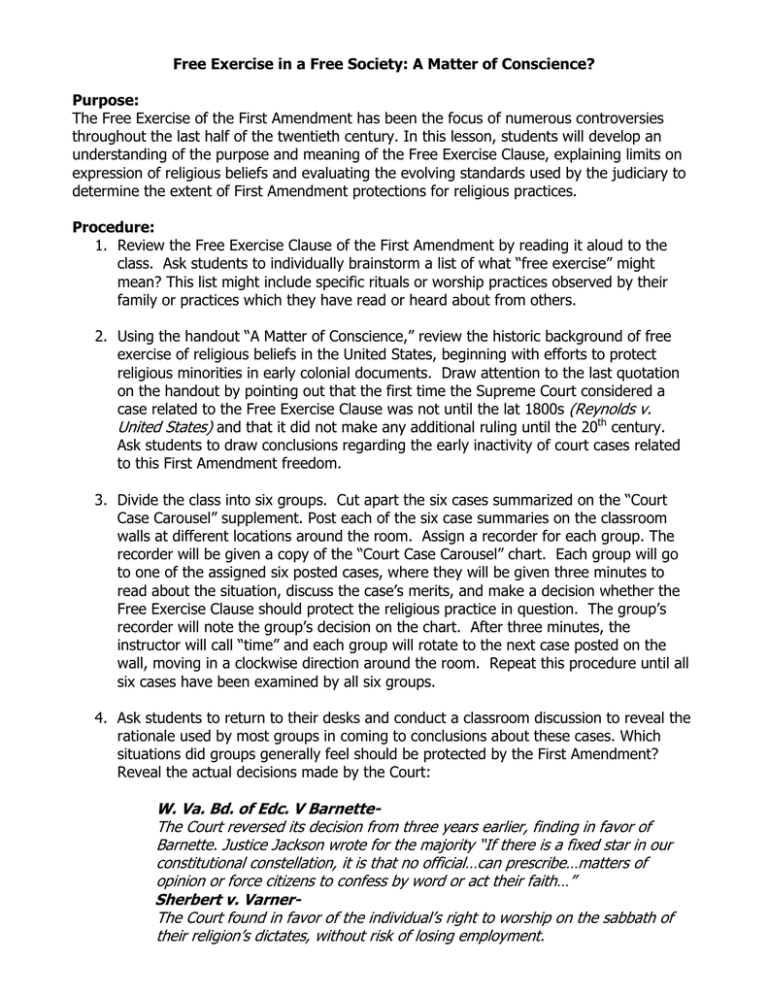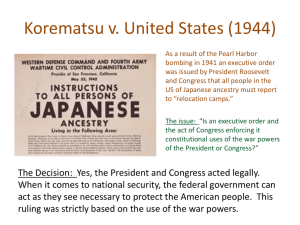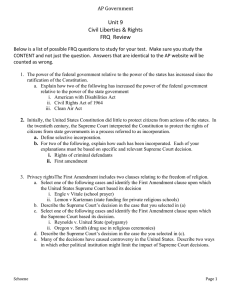Free Exercise in a Free Society: A Matter of Conscience? Purpose:
advertisement

Free Exercise in a Free Society: A Matter of Conscience? Purpose: The Free Exercise of the First Amendment has been the focus of numerous controversies throughout the last half of the twentieth century. In this lesson, students will develop an understanding of the purpose and meaning of the Free Exercise Clause, explaining limits on expression of religious beliefs and evaluating the evolving standards used by the judiciary to determine the extent of First Amendment protections for religious practices. Procedure: 1. Review the Free Exercise Clause of the First Amendment by reading it aloud to the class. Ask students to individually brainstorm a list of what “free exercise” might mean? This list might include specific rituals or worship practices observed by their family or practices which they have read or heard about from others. 2. Using the handout “A Matter of Conscience,” review the historic background of free exercise of religious beliefs in the United States, beginning with efforts to protect religious minorities in early colonial documents. Draw attention to the last quotation on the handout by pointing out that the first time the Supreme Court considered a case related to the Free Exercise Clause was not until the lat 1800s (Reynolds v. United States) and that it did not make any additional ruling until the 20th century. Ask students to draw conclusions regarding the early inactivity of court cases related to this First Amendment freedom. 3. Divide the class into six groups. Cut apart the six cases summarized on the “Court Case Carousel” supplement. Post each of the six case summaries on the classroom walls at different locations around the room. Assign a recorder for each group. The recorder will be given a copy of the “Court Case Carousel” chart. Each group will go to one of the assigned six posted cases, where they will be given three minutes to read about the situation, discuss the case’s merits, and make a decision whether the Free Exercise Clause should protect the religious practice in question. The group’s recorder will note the group’s decision on the chart. After three minutes, the instructor will call “time” and each group will rotate to the next case posted on the wall, moving in a clockwise direction around the room. Repeat this procedure until all six cases have been examined by all six groups. 4. Ask students to return to their desks and conduct a classroom discussion to reveal the rationale used by most groups in coming to conclusions about these cases. Which situations did groups generally feel should be protected by the First Amendment? Reveal the actual decisions made by the Court: W. Va. Bd. of Edc. V BarnetteThe Court reversed its decision from three years earlier, finding in favor of Barnette. Justice Jackson wrote for the majority “If there is a fixed star in our constitutional constellation, it is that no official…can prescribe…matters of opinion or force citizens to confess by word or act their faith…” Sherbert v. VarnerThe Court found in favor of the individual’s right to worship on the sabbath of their religion’s dictates, without risk of losing employment. U.S. v. KuchThe case was not accepted by the Supreme Court, who upheld a federal court’s ruling that the church’s religious beliefs and use of marijuana were not a sincere nor genuine faith. Welsh v. U.S.The Supreme Court’s 6-3 ruling expanded the status of “conscientious objector”to include anyone whose moral or philosophical tenets opposed all warfare. Massachusetts v. TwitchellsIn a unanimous decision, the Court ruled that the parents’ religious convictions did not supersede the physical needs of the child, who had not yet consciously chosen such religious beliefs; the state’s role to protect the welfare of the child was superior to parents’ beliefs. Church of Lukumi Bablu Aye v. HialeahThe Court’s 7-2 ruling found the city’s ordinances were unconstitutional and unfairly restricted religious practices. 5. Inform the class that the Supreme Court, over time, has debated how to come to conclusions about the Free Exercise Clause. Today, not all of the justices are in agreement as to how expansive the First Amendment should be, in addition to the standards to be used to determine which religious practices deserve constitutional protection. Inform students that they will be role-playing a Supreme Court mock oral argument involving one of the most significant cases in recent times- one that used what the Court calls the “Strict Scrutiny” standards- to weigh the needs of society versus the needs of individual religious liberties. 6. Distribute to all students (or place on an overhead transparency) the handout “What’s At Stake?” Review the major questions “at stake” they will be considering. After reading about the situation in Oregon v. Smith, students will use the “strict scrutiny” test to debate the issues of the case. Using the “You Decide” strategy, divide the class into three groups (attorneys for Oregon, attorneys for Smith, and Supreme Court Justices.) Permit time for each group to prepare their arguments and/or questions. Conduct a classroom mock oral argument, followed by a discussion by the justices, revealing their decision and reasoning. 7. Following the classroom mock oral argument, read aloud the following ruling and opinion offered by the U.S. Supreme Court: In a 6-3 decision, the Court held in support of Oregon and its state laws. The Free Exercise Clause permits the state to prohibit sacramental peyote use, and thus to deny unemployment benefits to persons discharged for such use. Justice Scalia delivered the opinion of the Court. “Respondents in the case seek to carry the meaning of ‘prohibiting the free exercise’…by contending that their religious motivation for using peyote places them beyond the reach of a criminal law that is not specifically directed at their religious practice…We have never held that an individual's religious beliefs excuse him from compliance with an otherwise valid law prohibiting conduct that the State is free to regulate. Conscientious scruples have not, in the course of the long struggle for religious toleration, relieved the individual from obedience to a general law not aimed at the promotion or restriction of religious beliefs. The mere possession of religious convictions which contradict the relevant concerns of a political society does not relieve the citizen from the discharge of political responsibilities." 8. Ask students if they agree or disagree with the decision. Based on the structure of our federal government, what can individuals or groups do if they disagree with Supreme Court rulings? What other actions can or should be taken if citizens wish to demand constitutional liberties unrecognized by the highest court in the nation? Distribute copies of the handout “A Nation Rejects a Ruling” and review the actual events following the Court’s ruling in Oregon v. Smith. Point out actions taken by both state legislatures and the U.S. Congress. Read aloud the Religious Freedom Restoration Act. Do students see the need for such a law? How strongly did the public support the law? 9. For enrichment or extension, assign students the task of investigating what happened next. How did the Supreme Court respond to this act of Congress? Research the case City of Boerne v. Flores to discover that a conflict beginning with the First Amendment has grown into a conflict between government branches involving principles such as “separation of powers” and “checks and balances.” (Students may wish to access the website http://www.oyez.org/cases/1990-1999/1996/1996_95_2074/ for information, to listen to oral arguments, and to read the Court’s opinion.) A Nation Rejects a Ruling: What Happens When the Public Disagrees? What happens when a significant segment of our society disagrees with a Supreme Court decision? Let’s find out! Following the 6-3 decision of the Supreme Court upholding a state’s criminal statutes over an individual’s right to freedom of religious expression, the public responded in the following manner: ► 23 states, including Oklahoma but not Oregon, passed state legislation specifically permitting use of peyote in Native American Church ceremonies. ► Leaders from over 60 national religious organizations lobbied Congress to protest the use of the new “strict scrutiny” test which would make it easier for government to restrict religious practices deemed as “inappropriate” under community standards. ► The U.S. Congress passes the Religious Freedom Restoration Act (1993) offering “blanket” exemptions to all religious practices. (The vote in the House was unanimous; the Senate passed the law by a 97-3 margin; President Clinton signed the act into law.) H.R. 1308 To protect the free exercise of religion In the House of Representatives March 11, 1993 1 2 3 4 5 6 7 8 9 10 11 12 13 14 15 16 17 18 19 Be it enacted by the Senate and House of Representatives of the United States of America In Congress assembled, This act may be cited as the Religious Freedom Restoration Act of 1993. Congress finds (1) the framers of the American Constitution, recognizing free exercise of religion as an unalienable right, secured its protection in the First Amendment to the Constitution; (2) laws “neutral” toward religion may burden religious exercise as surely as laws intended to interfere with religious exercise; (3) governments should not burden religious exercise without compelling justification. The purpose of this act is (1) to restore to local control all activities of an extra-curricular nature, and (2) to grant individuals and communities the opportunity to express religious convictions Openly. Government shall not burden a person’s exercise of religion. School boards will be permitted the option to provide a time, place, and opportunity for voluntary, student-led devotions, speech, or prayers outside the normal instructional day, including extra-curricular events sponsored by the school board. This act applies to all federal and state laws and the implementation of that law, whether Statutory or otherwise and whether adopted before or after the enactment of this act. ►What happened next? Research this case to find out: City of Boerne v. Flores (http://www.oyez.org)





